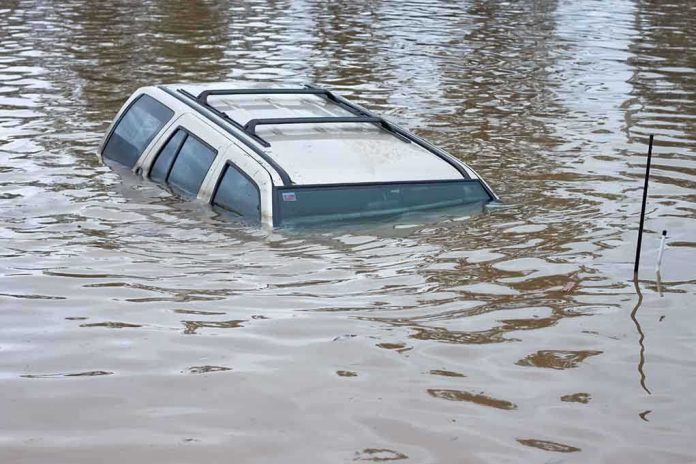
Entire villages vanished in hours as Nepal’s mountains unleashed a deadly torrent, leaving the living to ask if the land is turning against them.
Story Snapshot
- At least 44 people confirmed dead as landslides and floods devastate Nepalese villages.
- Extreme rainfall, fueled by shifting climate patterns, overwhelmed entire communities without warning.
- Government and armed forces scramble to rescue the missing and contain the chaos.
- The tragedy exposes Nepal’s mounting vulnerability in a world of escalating natural disasters.
Relentless Rains Bring Catastrophe to Nepal’s Heartland
Friday’s downpour did not just soak Nepal; it transformed the landscape into a gauntlet of mud, debris, and grief. The Ilam district in eastern Nepal bore the brunt, as homes, roads, and lives were buried beneath tons of shifting earth. By Sunday, the death toll had climbed to at least 44, with dozens still missing. The violence of the slides—whole hillsides collapsing in seconds—left seasoned villagers and first responders alike grasping for answers as to how the familiar had become so deadly, so fast.
Rescue teams, led by Nepal’s Armed Police Force, waded through waist-high mud and unstable terrain to find survivors. Helicopters ferried the injured to overwhelmed hospitals while rivers, swollen and angry, threatened to erase what little remained. As the rain refused to relent, anxiety spread faster than the floodwaters, especially in rural communities where communication lines snapped and help seemed a distant promise.
Landslides: A Deadly Tradition in the Shadow of the Himalayas
Nepal’s stunning peaks conceal a brutal truth: the country is a perennial victim of landslides and floods. The monsoon, once a predictable rhythm, is now a roulette wheel thanks to the warming planet. These disasters are not new, but the latest tragedy’s scale stuns even veteran officials. Residents recall previous floods, but they say the land feels different now—less forgiving, more prone to sudden violence. For many, the disaster is not just a crisis but a warning, a symptom of a world out of balance.
Villages perched on precarious slopes have always endured risk. Yet, with climate change driving more intense and erratic rainfall, the threat is morphing from seasonal nuisance to existential peril. Experts argue that while Nepal’s topography ensures some vulnerability, unchecked deforestation, population pressures, and insufficient infrastructure have multiplied the danger. The result: entire communities now live at the mercy of the next cloudburst.
Desperation, Determination, and the Race for Relief
As the government declared a state of emergency, the nation’s focus narrowed to survival and rescue. The Armed Police Force coordinated frantic searches for the missing, while local volunteers formed human chains to dig through debris and ferry supplies across collapsed bridges. The mood is a volatile mix of grief, frustration, and stubborn hope. Many survivors question whether enough has been done to safeguard their villages, especially as early warning systems and evacuation plans lag behind the pace of disaster.
#nepalfloods ,Oct 5 Floods displace thousands in Kathmandu Valley & eastern #Nepal after 3 days of rain. 8 rivers exceed danger levels. Army & police evacuate families amid submerged streets. Two-day public holiday declared. Landslides & overflows threaten more disruption. pic.twitter.com/b3ARoH7vN0
— Thepagetoday (@thepagetody) October 5, 2025
Government officials, under mounting pressure, have called for international aid and promised to invest in disaster preparedness. Critics, however, point to repeated failures to implement lasting solutions, from reforestation to improved drainage and building codes. The gap between promise and action is as wide as any river cutting through the battered countryside. For now, the survivors cling to one another and to the hope that this calamity might finally force overdue change.
Climate Change, Vulnerability, and the Road Ahead
Nepal’s tragedy is a case study in how global climate shifts are rewriting the rules for vulnerable nations. Scientists warn that as storms intensify, countries like Nepal, wedged between mountains and monsoon, will pay the highest price. The economic toll from destroyed infrastructure, lost crops, and emergency relief compounds the human suffering, threatening long-term recovery. Socially, the disruption of community ties and forced displacement leave wounds that linger long after the news cycle fades.
The world watches, but for those on the ground, resilience is not a slogan but a necessity. Calls grow louder for sustainable development, climate adaptation, and community-led disaster readiness. Without decisive action, the pattern will repeat: rain will fall, earth will move, and the headlines will count the dead. Yet, in the battered villages, hope persists that tragedy can be a turning point, not just a recurring nightmare.
Sources:
Landslides, lightning strike and flooding kill at least 22 in Nepal







